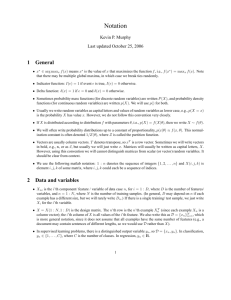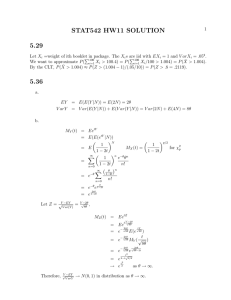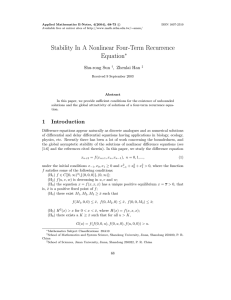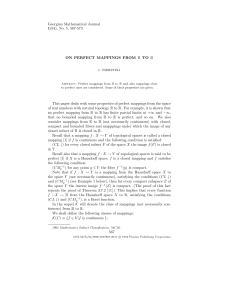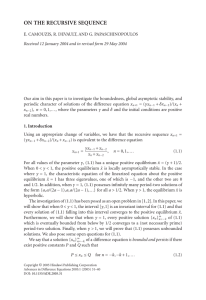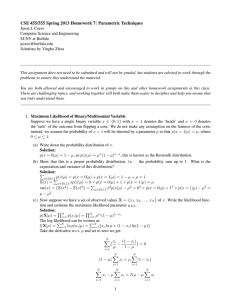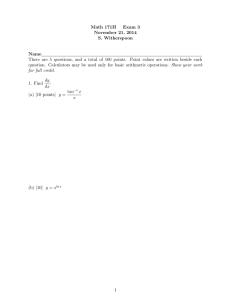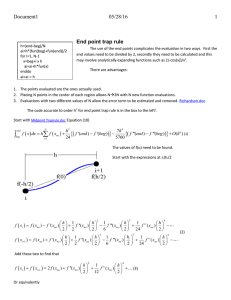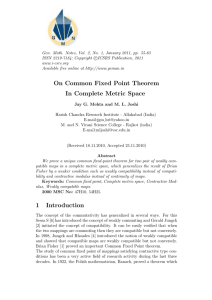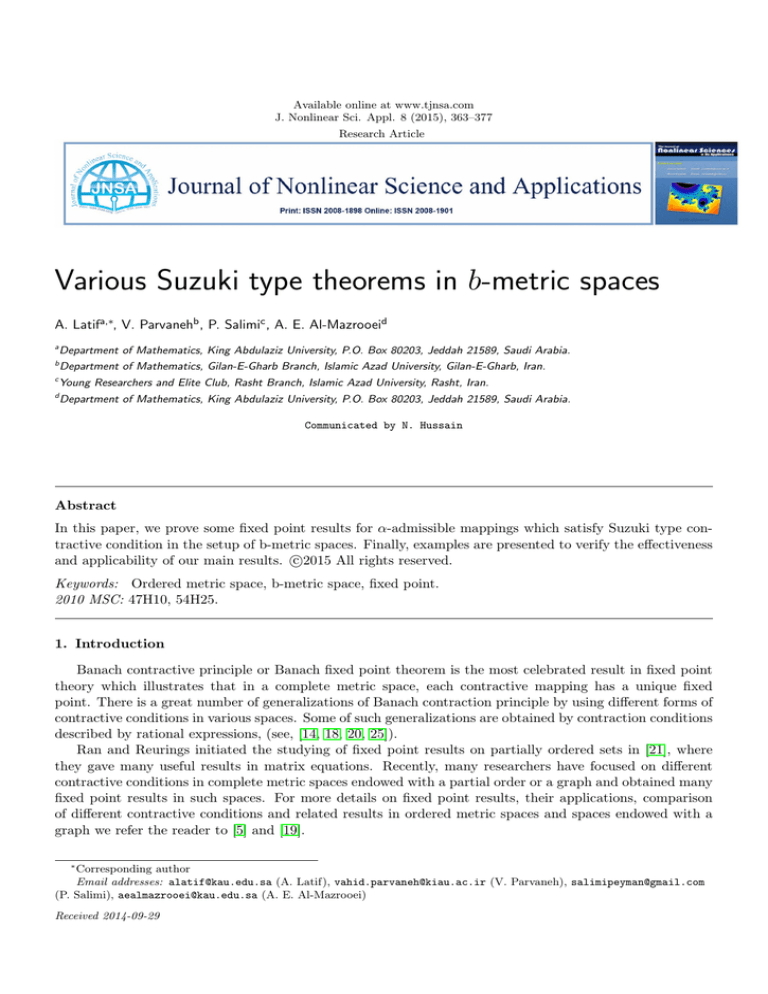
Available online at www.tjnsa.com
J. Nonlinear Sci. Appl. 8 (2015), 363–377
Research Article
Various Suzuki type theorems in b-metric spaces
A. Latifa,∗, V. Parvanehb , P. Salimic , A. E. Al-Mazrooeid
a
Department of Mathematics, King Abdulaziz University, P.O. Box 80203, Jeddah 21589, Saudi Arabia.
b
Department of Mathematics, Gilan-E-Gharb Branch, Islamic Azad University, Gilan-E-Gharb, Iran.
c
Young Researchers and Elite Club, Rasht Branch, Islamic Azad University, Rasht, Iran.
d
Department of Mathematics, King Abdulaziz University, P.O. Box 80203, Jeddah 21589, Saudi Arabia.
Communicated by N. Hussain
Abstract
In this paper, we prove some fixed point results for α-admissible mappings which satisfy Suzuki type contractive condition in the setup of b-metric spaces. Finally, examples are presented to verify the effectiveness
c
and applicability of our main results. 2015
All rights reserved.
Keywords: Ordered metric space, b-metric space, fixed point.
2010 MSC: 47H10, 54H25.
1. Introduction
Banach contractive principle or Banach fixed point theorem is the most celebrated result in fixed point
theory which illustrates that in a complete metric space, each contractive mapping has a unique fixed
point. There is a great number of generalizations of Banach contraction principle by using different forms of
contractive conditions in various spaces. Some of such generalizations are obtained by contraction conditions
described by rational expressions, (see, [14, 18, 20, 25]).
Ran and Reurings initiated the studying of fixed point results on partially ordered sets in [21], where
they gave many useful results in matrix equations. Recently, many researchers have focused on different
contractive conditions in complete metric spaces endowed with a partial order or a graph and obtained many
fixed point results in such spaces. For more details on fixed point results, their applications, comparison
of different contractive conditions and related results in ordered metric spaces and spaces endowed with a
graph we refer the reader to [5] and [19].
∗
Corresponding author
Email addresses: alatif@kau.edu.sa (A. Latif), vahid.parvaneh@kiau.ac.ir (V. Parvaneh), salimipeyman@gmail.com
(P. Salimi), aealmazrooei@kau.edu.sa (A. E. Al-Mazrooei)
Received 2014-09-29
A. Latif, V. Parvaneh, P. Salimi, A. E. Al-Mazrooei, J. Nonlinear Sci. Appl. 8 (2015), 363–377
364
Czerwik in [8] introduced the concept of a b-metric space. Since then, several papers dealt with fixed
point theory for single-valued and multi-valued operators in b-metric spaces (see, [7, 9, 16, 22]).
Definition 1.1. Let X be a (nonempty) set and s ≥ 1 be a given real number. A function d : X × X → R+
is a b-metric if, for all x, y, z ∈ X, the following conditions are satisfied:
(b1 ) d(x, y) = 0 iff x = y,
(b2 ) d(x, y) = d(y, x),
(b3 ) d(x, z) ≤ s[d(x, y) + d(y, z)].
In this case, the pair (X, d) is called a b-metric space.
Definition 1.2 ([6]). Let (X, d) be a b-metric space.
(a) A sequence {xn } in X is called b-convergent if and only if there exists x ∈ X such that d(xn , x) → 0,
as n → ∞. In this case, we write lim xn = x.
n→∞
(b) {xn } in X is said to be b-Cauchy if and only if d(xn , xm ) → 0, as n, m → ∞.
(c) The b-metric space (X, d) is b-complete if every b-Cauchy sequence in X is b-converges.
Note that a b-metric need not to be a continuous function. The following example (corrected from [13])
illustrates this fact.
Example 1.3. Let X = N ∪ {∞} and let d : X × X → R be defined by
0,
if m = n,
| 1 − 1 |, if one of m, n is even and the other is even or ∞,
m
n
d(m, n) =
5,
if one of m, n is odd and the other is odd (and m 6= n) or ∞,
2,
otherwise.
It can be checked that for all m, n, p ∈ X, we have
5
d(m, p) ≤ (d(m, n) + d(n, p)).
2
Thus, (X, d) is a b-metric space (with s = 5/2). Let xn = 2n for each n ∈ N. Then
d(2n, ∞) =
1
→0
2n
as n → ∞,
that is, xn → ∞, but d(xn , 1) = 2 6→ 5 = d(∞, 1) as n → ∞.
Lemma 1.4 ([1]). Let (X, d) be a b-metric space with s ≥ 1, and suppose that {xn } and {yn } are b-convergent
to x and y, respectively. Then we have
1
d(x, y) ≤ lim inf d(xn , yn ) ≤ lim sup d(xn , yn ) ≤ s2 d(x, y).
n→∞
s2
n→∞
In particular, if x = y, then we have lim d(xn , yn ) = 0. Moreover, for each z ∈ X, we have,
n→∞
1
d(x, z) ≤ lim inf d(xn , z) ≤ lim sup d(xn , z) ≤ sd(x, z).
n→∞
s
n→∞
Let S denotes the class of all real functions β : [0, +∞) → [0, 1) satisfying the condition
β(tn ) → 1 implies that tn → 0, as n → ∞.
In order to generalize the Banach contraction principle, in 1973, Geraghty proved the following.
A. Latif, V. Parvaneh, P. Salimi, A. E. Al-Mazrooei, J. Nonlinear Sci. Appl. 8 (2015), 363–377
365
Theorem 1.5 ([12]). Let (X, d) be a complete metric space, and let f : X → X be a self-map. Suppose that
there exists β ∈ S such that
d(f x, f y) ≤ β(d(x, y))d(x, y)
holds for all x, y ∈ X. Then f has a unique fixed point z ∈ X and for each x ∈ X the Picard sequence {f n x}
converges to z.
In [10], some fixed point theorems for Geraghty-type contractive mappings in various generalized metric
spaces are proved. As in [10], we will consider the class of functions F, where β ∈ F if β : [0, ∞) → [0, 1/s)
has the property
1
β(tn ) → implies that tn → 0, as n → ∞.
s
Theorem 1.6 ([10]). Let s > 1, and let (X, D, s) be a complete metric type space. Suppose that a mapping
f : X → X satisfies the condition
D(f x, f y) ≤ β(D(x, y))D(x, y)
for all x, y ∈ X and some β ∈ F. Then f has a unique fixed point z ∈ X, and for each x ∈ X the Picard
sequence {f n x} converges to z in (X, D, s).
Unification of the recent results of Zabihi and Razani [28] yield the following result.
Theorem 1.7. Let (X, ) be a partially ordered set and suppose that there exists a b-metric d on X such
that (X, d) is a b-complete b-metric space (with parameter s > 1). Let f : X → X be an increasing mapping
with respect to such that there exists an element x0 ∈ X with x0 f (x0 ). Suppose that there exists β ∈ F
such that,
sd(f x, f y) ≤ β(d(x, y))M (x, y) + LN (x, y)
(1.1)
for all comparable elements x, y ∈ X, where L ≥ 0,
d(x, f x)d(y, f y)
M (x, y) = max d(x, y),
1 + d(f x, f y)
and
N (x, y) = min{d(x, f x), d(x, f y), d(y, f x), d(y, f y)}.
If f is continuous, or, whenever {xn } is a nondecreasing sequence in X such that xn → u ∈ X, one has
xn u for all n ∈ N, then f has a fixed point. Moreover, the set of fixed points of f is well ordered if and
only if f has one and only one fixed point.
One of the interesting results which generalizes the Banach contraction principle was given by Samet et
al. [23] by defining α-ψ-contractive mappings.
Definition 1.8 ([23]). Let T be a self-mapping on X and let α : X × X → [0, ∞) be a function. We say
that T is an α-admissible mapping if
x, y ∈ X,
α(x, y) ≥ 1
=⇒
α(T x, T y) ≥ 1.
Denote with Ψ0 the family of all nondecreasing functions ψ : [0, ∞) → [0, ∞) such that
for all t > 0, where ψ n is the n-th iterate of ψ.
P∞
n=1 ψ
n (t)
<∞
Theorem 1.9 ([23]). Let (X, d) be a complete metric space and let T be an α-admissible mapping. Assume
that
α(x, y)d(T x, T y) ≤ ψ(d(x, y))
(1.2)
where ψ ∈ Ψ0 . Also, suppose that the following assertions hold:
A. Latif, V. Parvaneh, P. Salimi, A. E. Al-Mazrooei, J. Nonlinear Sci. Appl. 8 (2015), 363–377
366
(i) there exists x0 ∈ X such that α(x0 , T x0 ) ≥ 1;
(ii) either T is continuous, or, for any sequence {xn } in X with α(xn , xn+1 ) ≥ 1 for all n ∈ N ∪ {0} such
that xn → x as n → ∞, we have α(xn , x) ≥ 1 for all n ∈ N ∪ {0}.
Then T has a fixed point.
Definition 1.10 ([17]). Let f : X → X and α : X × X → [0, +∞). We say that f is a triangular
α-admissible mapping if
(T1) α(x, y) ≥ 1
(T2)
implies
α(x, z) ≥ 1
α(z, y) ≥ 1
α(f x, f y) ≥ 1,
α(x, y) ≥ 1,
implies
x, y ∈ X,
x, y, z ∈ X.
√
Example 1.11 ([17]). Let X = R, f x = 3 x and α(x, y) = ex−y , then f is a triangular α-admissible
mapping. Indeed, ifα(x, y) = ex−y ≥ 1, then
x ≥ y which implies that f x ≥ f y, that is, α(f x, f y) =
α(x,
z)
≥
1
x − z ≥ 0,
ef x−f y ≥ 1. Also, if
, then
that is, x − y ≥ 0 and so, α(x, y) = ex−y ≥ 1.
α(z, y) ≥ 1
z − y ≥ 0,
Lemma 1.12 ([17]). Let f be a triangular α-admissible mapping. Assume that there exists x0 ∈ X such
that α(x0 , f x0 ) ≥ 1. Define sequence {xn } by xn = f n x0 . Then
α(xm , xn ) ≥ 1 for all m, n ∈ N with m < n.
We now recall the concept of (c)-comparison function which was introduced by Berinde [4].
Definition 1.13 ([4]). A function ϕ : [0, ∞) → [0, ∞) is said to be a (c)-comparison function if
(c1 ) ϕ is increasing,
(c2 ) there exists k0 ∈ N, a ∈ (0, 1) and a convergent series of nonnegative terms
∞
X
vk such that ϕk+1 (t) ≤
k=1
aϕk (t) + vk , for k ≥ k0 and any t ∈ [0, ∞).
Later, Berinde [3] introduced the notion of a (b)-comparison function as a generalization of the concept
of (c)-comparison function.
Definition 1.14 ([3]). Let s ≥ 1 be a real number. A mapping ϕ : [0, ∞) → [0, ∞) is called a (b)-comparison
function if the following conditions are fulfilled
(1) ϕ is monotone increasing;
(2) there exist k0 ∈ N, a ∈ (0, 1) and a convergent series of nonnegative terms
∞
X
vk such that sk+1 ϕk+1 (t) ≤
k=1
ask ϕk (t) + vk for any k ≥ k0 and any t ∈ [0, ∞).
Let Ψb be the class of all (b)-comparison functions ϕ : [0, ∞) → [0, ∞). It is clear that the notion of
(b)-comparison function coincide with (c)-comparison function for s = 1.
We now recall the following lemma which will simplify the proofs.
Lemma 1.15 ([2]). If ϕ : [0, ∞) → [0, ∞) is a (b)-comparison function, then we have the following.
(1) the series
∞
X
sk ϕk (t) converges for any t ∈ R+ ;
k=0
(2) the function bs : [0, ∞) → [0, ∞) defined by bs (t) =
at 0.
∞
X
k=0
sk ϕk (t), t ∈ [0, ∞), is increasing and continuous
A. Latif, V. Parvaneh, P. Salimi, A. E. Al-Mazrooei, J. Nonlinear Sci. Appl. 8 (2015), 363–377
367
2. Main Results
In 1962, Edelstein [11] proved an interesting version of Banach contraction principle. In 2009, Suzuki
[27] proved certain remarkable results to improve the results of Banach and Edelstein (see also [24, 26]).
Now, we are ready to prove the following Suzuki type theorems for nonlinear contractions.
Theorem 2.1. Let (X, d) be a b-complete b-metric space (with parameter s > 1) and let f be a triangular
α-admissible mapping. Suppose that there exists β ∈ F such that,
1
d(x, f x) ≤ d(x, y) =⇒ sα(x, y)d(f x, f y) ≤ β(M (x, y))M (x, y)
2s
(2.1)
for all x, y ∈ X, where
d(x, f x)d(x, f y) + d(y, f y)d(y, f x)
,
1 + s[d(x, y) + d(f x, f y)]
d(x, f x)d(x, f y) + d(y, f y)d(y, f x)
.
1 + d(x, f y) + d(y, f x)
M (x, y) = max d(x, y),
Also, suppose that the following assertions hold:
(i) there exists x0 ∈ X such that α(x0 , f x0 ) ≥ 1;
(ii) for any sequence {xn } in X with α(xn , xn+1 ) ≥ 1 for all n ∈ N ∪ {0} such that xn → x as n → ∞, we
have α(xn , x) ≥ 1 for all n ∈ N ∪ {0}.
Then, T has a fixed point.
Proof. Let x0 ∈ X be such that α(x0 , f x0 ) ≥ 1. Define a sequence {xn } by xn = f n x0 for all n ∈ N. Since
f is an α-admissible mapping and α(x0 , x1 ) = α(x0 , f x0 ) ≥ 1, we deduce that α(x1 , x2 ) = α(f x0 , f x1 ) ≥ 1.
Continuing this process, we get that α(xn , xn+1 ) ≥ 1 for all n ∈ N ∪ {0}. We will do the proof in the
following steps.
1
Step I: We will show that lim d(xn , xn+1 ) = 0. Since α(xn , xn+1 ) ≥ 1 for each n ∈ N, and 2s
d(xn−1 , f xn−1 ) ≤
n→∞
d(xn−1 , xn ) then by (2.1) we have
d(xn , xn+1 ) = d(f xn−1 , f xn )
≤ sα(xn−1 , xn )d(f xn−1 , f xn )
≤ β(M (xn−1 , xn ))M (xn−1 , xn )
≤ β(d(xn−1 , xn ))d(xn−1 , xn )
< 1s d(xn−1 , xn )
≤ d(xn−1 , xn ),
because
M (xn−1 , xn ) = max{d(xn−1 , xn ),
d(xn−1 , f xn−1 )d(xn−1 , f xn ) + d(xn , f xn )d(xn , f xn−1 )
,
1 + s[d(xn−1 , xn ) + d(f xn−1 , f xn )]
d(xn−1 , f xn−1 )d(xn−1 , f xn ) + d(xn , f xn )d(xn , f xn−1 )
}
1 + d(xn−1 , f xn ) + d(xn , f xn−1 )
= max{d(xn−1 , xn ),
d(xn−1 , xn )d(xn−1 , xn+1 ) + d(xn , xn+1 )d(xn , xn )
,
1 + s[d(xn−1 , xn ) + d(xn , xn+1 )]
d(xn−1 , xn )d(xn−1 , xn+1 ) + d(xn , xn+1 )d(xn , xn )
}
1 + d(xn−1 , xn+1 ) + d(xn , xn )
=d(xn−1 , xn ).
(2.2)
A. Latif, V. Parvaneh, P. Salimi, A. E. Al-Mazrooei, J. Nonlinear Sci. Appl. 8 (2015), 363–377
368
Therefore, {d(xn , xn+1 )} is decreasing. Then there exists r ≥ 0 such that lim d(xn , xn+1 ) = r. We will
n→∞
prove that r = 0. Suppose on contrary that r > 0. Then, letting n → ∞, from (2.2) we have
1
r ≤ lim β(d(xn−1 , xn ))r
n→∞
s
which implies that d(xn−1 , xn ) → 0. Hence, r = 0, a contradiction. So,
lim d(xn−1 , xn ) = 0
n→∞
(2.3)
holds true.
Step II: Now, we prove that the sequence {xn } is a b-Cauchy sequence. Suppose the contrary, i.e., that
{xn } is not a b-Cauchy sequence. Then there exists ε > 0 for which we can find two subsequences {xmi }
and {xni } of {xn } such that ni is the smallest index for which
ni > mi > i and d(xmi , xni ) ≥ ε.
(2.4)
d(xmi , xni −1 ) < ε.
(2.5)
This means that
From ((2.4)) and using the triangular inequality, we get
ε ≤ d(xmi , xni ) ≤ sd(xmi , xmi +1 ) + sd(xmi +1 , xni ).
Taking the upper limit as i → ∞, we get
ε
≤ lim sup d(xmi +1 , xni ).
s
i→∞
(2.6)
Remember that, from (2.2) we get,
d(xn , xn+1 ) < d(xn−1 , xn )
(2.7)
for all n ∈ N. Suppose that there exists i0 ∈ N such that,
1
d(xmi0 , f xmi0 ) > d(xmi0 , xni0 −1 )
2s
and
1
d(xmi0 +1 , f xmi0 +1 ) > d(xmi0 +1 , xni0 −1 ).
2s
Then from (2.7) we have,
d(xmi0 , xmi0 +1 ) ≤ s[d(xmi0 , xni0 −1 ) + d(xmi0 +1 , xni0 −1 )]
1
1
< s[ d(xmi0 , f xmi0 ) + d(xmi0 +1 , f xmi0 +1 )]
2s
2s
1
= [d(xmi0 , xmi0 +1 ) + d(xmi0 +1 , xmi0 +2 )]
2
1
≤ [d(xmi0 , xmi0 +1 ) + d(xmi0 , xmi0 +1 )] = d(xmi0 , xmi0 +1 )
2
which is a contradiction. Hence, either,
1
d(xmi , f xmi ) ≤ d(xmi , xni −1 )
2s
or
1
d(xmi +1 , f xmi +1 ) ≤ d(xmi +1 , xni −1 )
2s
A. Latif, V. Parvaneh, P. Salimi, A. E. Al-Mazrooei, J. Nonlinear Sci. Appl. 8 (2015), 363–377
369
holds for all i ∈ N.
First suppose that
1
d(xmi , f xmi ) ≤ d(xmi , xni −1 ).
2s
As from Lemma 1.12, α(xmi , xni −1 ) ≥ 1, we obtain that
s·
ε
≤ s · lim sup d(xmi +1 , xni ) ≤ lim sup β(M (xmi , xni −1 )) lim sup M (xmi , xni −1 )
s
i→∞
i→∞
i→∞
≤ ε lim sup β(M (xmi , xni −1 ))
i→∞
because, from the definition of M (x, y) and the above limits,
lim sup M (xmi , xni −1 ) = lim sup max{d(xmi , xni −1 ),
i→∞
i→∞
d(xmi , f xmi )d(xmi , f xni −1 ) + d(xni −1 , f xni −1 )d(xni −1 , f xmi )
,
1 + s[d(xmi , xni −1 ) + d(f xmi , f xni −1 )]
d(xmi , f xmi )d(xmi , f xni −1 ) + d(xni −1 , f xni −1 )d(xni −1 , f xmi )
}
1 + d(xmi , f xni −1 ) + d(xni −1 , f xmi )
= lim sup max{d(xmi , xni −1 ),
i→∞
d(xmi , xmi +1 )d(xmi , xni ) + d(xni −1 , xni )d(xni −1 , xmi +1 )
,
1 + s[d(xmi , xni −1 ) + d(xmi +1 , xni )]
d(xmi , xmi +1 )d(xmi , xni ) + d(xni −1 , xni )d(xni −1 , xmi +1 )
}
1 + d(xmi , xni ) + d(xni −1 , xmi +1 )
≤ ε,
which implies that
1
s
≤ lim sup β(M (xmi , xni −1 )). Now, as β ∈ F we conclude that M (xmi , xni −1 ) → 0,
i→∞
hence, we get that d(xmi , xni −1 ) → 0 which implies that d(xmi , xni ) → 0, a contradiction to 2.4. So, {xn }
is a b-Cauchy sequence. b-Completeness of X yields that {xn } b-converges to a point x∗ ∈ X.
On the other hand, from ((2.4)) and using the triangular inequality, we get
ε
≤ d(xmi , xni ) ≤ sd(xmi , xmi +2 ) + sd(xmi +2 , xni ).
s
Taking the upper limit as i → ∞, we get
ε
≤ lim sup d(xmi +2 , xni ).
s
i→∞
(2.8)
Also, from ((2.6)) and using the triangular inequality, we get
d(xmi +1 , xni −1 ) ≤ sd(xmi +1 , xni ) + sd(xni , xni −1 ).
Taking the upper limit as i → ∞, we get
lim sup d(xmi +1 , xni −1 ) ≤ sε.
i→∞
Now, let
1
d(xmi +1 , f xmi +1 ) ≤ d(xmi +1 , xni −1 ).
2s
From Lemma 1.12, α(xmi +1 , xni −1 ) ≥ 1, so, we have
s·
ε
≤ s · lim sup d(xmi +2 , xni ) ≤ lim sup β(M (xmi +1 , xni −1 )) lim sup M (xmi +1 , xni −1 )
s
i→∞
i→∞
i→∞
≤ sε lim sup β(M (xmi +1 , xni −1 ))
i→∞
(2.9)
A. Latif, V. Parvaneh, P. Salimi, A. E. Al-Mazrooei, J. Nonlinear Sci. Appl. 8 (2015), 363–377
370
because,
lim sup M (xmi +1 , xni −1 ) = lim sup max{d(xmi +1 , xni −1 ),
i→∞
i→∞
d(xmi +1 , f xmi +1 )d(xmi +1 , f xni −1 ) + d(xni −1 , f xni −1 )d(xni −1 , f xmi +1 )
,
1 + s[d(xmi +1 , xni −1 ) + d(f xmi +1 , f xni −1 )]
d(xmi +1 , f xmi +1 )d(xmi +1 , f xni −1 ) + d(xni −1 , f xni −1 )d(xni −1 , f xmi +1 )
}
1 + d(xmi +1 , f xni −1 ) + d(xni −1 , f xmi +1 )
= lim sup max{d(xmi +1 , xni −1 ),
i→∞
d(xmi +1 , xmi +2 )d(xmi +1 , xni ) + d(xni −1 , xni )d(xni −1 , xmi +2 )
,
1 + s[d(xmi +1 , xni −1 ) + d(xmi +2 , xni )]
d(xmi +1 , xmi +2 )d(xmi +1 , xni ) + d(xni −1 , xni )d(xni −1 , xmi +2 )
}
1 + d(xmi +1 , xni ) + d(xni −1 , xmi +2 )
≤ sε,
which implies that
1
s
≤ lim sup β(M (xmi +1 , xni −1 )). Now, as β ∈ F we conclude that M (xmi +1 , xni −1 ) → 0,
i→∞
hence, we get that d(xmi +1 , xni −1 ) → 0 which implies that d(xmi , xni ) → 0, a contradiction. So, {xn } is a
b-Cauchy sequence. b-Completeness of X yields that {xn } b-converges to a point x∗ ∈ X.
Remember that, from (2.2) we get,
d(xn , xn+1 ) < d(xn−1 , xn )
(2.10)
for all n ∈ N. Suppose that there exists n0 ∈ N such that,
1
d(xn0 , f xn0 ) > d(xn0 , x∗ )
2s
and
1
d(xn0 +1 , f xn0 +1 ) > d(xn0 +1 , x∗ ).
2s
Then, from (2.10) we have,
d(xn0 , xn0 +1 ) ≤ s[d(xn0 , x∗ ) + d(xn0 +1 , x∗ )]
1
1
< s[ d(xn0 , f xn0 ) + d(xn0 +1 , f xn0 +1 )]
2s
2s
1
= [d(xn0 , xn0 +1 ) + d(xn0 +1 , xn0 +2 )]
2
1
≤ [d(xn0 , xn0 +1 ) + d(xn0 , xn0 +1 )] = d(xn0 , xn0 +1 )
2
which is a contradiction. Hence, either,
1
d(xn , f xn ) ≤ d(xn , x∗ )
2s
or
1
d(xn+1 , f xn+1 ) ≤ d(xn+1 , x∗ )
2s
holds for all n ∈ N. First, suppose that,
1
d(xn , f xn ) ≤ d(xn , x∗ )
2s
A. Latif, V. Parvaneh, P. Salimi, A. E. Al-Mazrooei, J. Nonlinear Sci. Appl. 8 (2015), 363–377
371
holds for all n ∈ N. Then from (2.1) we have,
d(f x∗ , x∗ ) ≤ s[d(f x∗ , f xn ) + d(f xn , x∗ )]
= s[d(f x∗ , f xn ) + d(xn+1 , x∗ )]
≤ s[β(M (x∗ , xn ))M (x∗ , xn ) + d(xn+1 , x∗ )]
for all n ∈ N. Taking the limit as n → ∞ in the above inequality we get, d(f x∗ , x∗ ) = 0. i.e.,
f x∗ = x∗ .
By a similar method we can deduce f x∗ = x∗ when
1
d(xn+1 , f xn+1 ) ≤ d(xn+1 , x∗ ).
2
Hence, we proved that x∗ is a fixed point of f .
Theorem 2.2. Let (X, d) be a b-complete b-metric space and let f be an α-admissible mapping. Suppose
that there exists ψ ∈ Ψb such that,
1
d(x, f x) ≤ d(x, y) =⇒ α(x, y)d(f x, f y) ≤ ψ(M (x, y))
(2.11)
2s
where,
d(x, f x)d(y, f y)
d(x, f y)d(x, y)
M (x, y) = max d(x, y),
,
,
1 + s[d(x, y) + d(x, f y)] 1 + s[d(x, f x) + d(y, f y)]
for all x, y ∈ X.
Also, suppose that the following assertions hold:
(i) there exists x0 ∈ X such that α(x0 , f x0 ) ≥ 1;
(ii) for any sequence {xn } in X with α(xn , xn+1 ) ≥ 1 for all n ∈ N ∪ {0} such that xn → x as n → ∞, we
have α(xn , x) ≥ 1 for all n ∈ N ∪ {0}.
Then, f has a fixed point.
Proof. Let x0 ∈ X be such that α(x0 , f x0 ) ≥ 1. Define a sequence {xn } by xn = f n x0 for all n ∈ N. Since
f is an α-admissible mapping and α(x0 , x1 ) = α(x0 , f x0 ) ≥ 1, we deduce that α(x1 , x2 ) = α(f x0 , f x1 ) ≥ 1.
Continuing this process, we get that α(xn , xn+1 ) ≥ 1 for all n ∈ N ∪ {0}.
If there exists n0 ∈ N such that xn0 = xn0 +1 then, xn0 = f xn0 and so we have no thing for prove. Hence,
for all n ∈ N we assume that d(xn , xn+1 ) > 0.
On the other hand, we have,
1
1
d(xn−1 , f xn−1 ) = d(xn−1 , xn ) ≤ d(xn−1 , xn )
2s
2
and α(xn , xn+1 ) ≥ 1, so by (2.11) we get,
d(xn , xn+1 ) = d(f xn−1 , f xn ) ≤ α(xn−1 , xn )d(f xn−1 , f xn ) ≤ ψ(M (xn−1 , xn ))
where,
d(xn−1 , f xn−1 )d(xn , f xn )
,
1 + s[d(xn−1 , xn ) + d(xn−1 , f xn )]
d(xn−1 , f xn )d(xn−1 , xn )
}
1 + s[d(xn−1 , f xn−1 ) + d(xn , f xn )]
d(xn−1 , xn )d(xn , xn+1 )
= max{d(xn−1 , xn ),
,
1 + s[d(xn−1 , xn ) + d(xn−1 , xn+1 )]
d(xn−1 , xn+1 )d(xn−1 , xn )
}
1 + s[d(xn−1 , xn ) + d(xn , xn+1 )]
= d(xn−1 , xn ).
M (xn−1 , xn ) = max{d(xn−1 , xn ),
(2.12)
A. Latif, V. Parvaneh, P. Salimi, A. E. Al-Mazrooei, J. Nonlinear Sci. Appl. 8 (2015), 363–377
372
Hence,
d(xn , xn+1 ) ≤ ψ(d(xn−1 , xn )) < d(xn−1 , xn ).
(2.13)
d(xn , xn+1 ) ≤ ψ(d(xn−1 , xn )) ≤ ψ 2 (d(xn−2 , xn−1 )) ≤ · · · ≤ ψ n (d(x0 , x1 )).
(2.14)
By induction, we get that
Then, by the triangular inequality and (2.14), we get
d(xn , xm ) ≤ sd(xn , xn+1 ) + s2 d(xn+1 , xn+2 ) + · · · + sm−n−1 d(xm−1 , xm )
≤
≤
m−2
X
k=n
∞
X
sk−n+1 ψ k (d(x0 , x1 ))
sk ψ k (d(x0 , x1 )) −→ 0,
k=n
as n −→ ∞.
Hence, {xn } is a b-Cauchy sequence. b-completeness of X yields that {xn } converges to a point x∗ ∈ X,
that is, xn → x∗ as n → ∞.
On the other hand, from (2.13) we get,
d(xn , xn+1 ) < d(xn−1 , xn )
(2.15)
for all n ∈ N. Suppose that there exists n0 ∈ N such that,
1
d(xn0 , f xn0 ) > d(xn0 , x∗ )
2s
and
1
d(xn0 +1 , f xn0 +1 ) > d(xn0 +1 , x∗ ).
2s
Then from (2.15) we have,
d(xn0 , xn0 +1 ) ≤ s[d(xn0 , x∗ ) + d(xn0 +1 , x∗ )]
1
1
< s[ d(xn0 , f xn0 ) + d(xn0 +1 , f xn0 +1 )]
2s
2s
1
= [d(xn0 , xn0 +1 ) + d(xn0 +1 , xn0 +2 )]
2
1
≤ [d(xn0 , xn0 +1 ) + d(xn0 , xn0 +1 )] = d(xn0 , xn0 +1 )
2
which is a contradiction. Hence, either,
1
d(xn , f xn ) ≤ d(xn , x∗ )
2s
or
1
d(xn+1 , f xn+1 ) ≤ d(xn+1 , x∗ )
2s
holds for all n ∈ N. First, suppose that,
1
d(xn , f xn ) ≤ d(xn , x∗ )
2s
holds for all n ∈ N. Then from (2.11) and hypothesis (ii), we have,
d(T x∗ , x∗ ) ≤ s[d(f x∗ , f xn ) + d(f xn , x∗ )]
≤ s[α(x∗ , xn )d(f x∗ , f xn ) + d(xn+1 , x∗ )]
≤ s[ψ(M (x∗ , xn )) + d(xn+1 , x∗ )]
A. Latif, V. Parvaneh, P. Salimi, A. E. Al-Mazrooei, J. Nonlinear Sci. Appl. 8 (2015), 363–377
373
for all n ∈ N. Taking the limit as n → ∞ in the above inequality we get, d(f x∗ , x∗ ) = 0. i.e.,
f x∗ = x∗ .
By a similar method we can deduce f x∗ = x∗ when
1
d(xn+1 , f xn+1 ) ≤ d(xn+1 , x∗ ).
2
Hence, we proved that x∗ is a fixed point of f .
Example 2.3. Let X = R2 . We define α : X × X → [0, ∞) by
1, x, y ∈ U = {(0, 0), (4, 0), (0, 4), (4, 5), (5, 4)}
α(x, y) =
0, otherwise.
Define metric d on X by d((x1 , x2 ), (y1 , y2 )) = (x1 −y1 )2 +(x2 −y2 )2 . Clearly, (X, d, 2) is a complete b-metric
space. Also, define f : X → X and ψ : [0, ∞) → [0, ∞) by
(x1 , 0),
If x1 ≤ x2 and x1 , x2 ∈ U
(0, x2 )
If x1 > x2 and x1 , x2 ∈ U and ψ(t) = 0.99t.
f (x1 , x2 ) =
(2x21 , 3x32 ) If x1 , x2 ∈ R2 \U
First we assume that 41 d(x, f x) ≤ d(x, y) and α(x, y) ≥ 1. Then,
n
(x, y) ∈
(0, 0), (4, 0) , (0, 0), (0, 4) , (0, 0), (4, 5) , (0, 0), (5, 4) ,
(4, 0), (0, 0) , (4, 0), (0, 4) , (4, 0), (5, 4) , (4, 0), (4, 5) ,
(0, 4), (0, 0) , (0, 4), (4, 0) , (0, 4), (5, 4) , (0, 4), (4, 5) ,
(4, 5), (0, 0) , (4, 5), (4, 0) , (4, 5), (0, 4) , (4, 5), (5, 4)
o
(5, 4), (0, 0) , (5, 4), (4, 0) , (5, 4), (0, 4) , (5, 4), (4, 5) .
Since, d(f x, f y) = d(f y, f x) and d(x, y) = d(y, x), hence without any loss of generality we can reduce the
above set to the following:
n
(x, y) ∈
(0, 0), (4, 0) , (0, 0), (0, 4) , (0, 0), (4, 5) , (0, 0), (5, 4) ,
o
(4, 0), (0, 4) , (4, 0), (5, 4) , (4, 0), (4, 5) , (0, 4), (5, 4) , (0, 4), (4, 5) .
Now, we consider the following cases:
• Let (x, y) = (0, 0), (4, 0) , then,
d(f x, f y) = d(f (0, 0), f (4, 0)) = 0 ≤ ψ(d(x, y)).
• Let (x, y) = (0, 0), (0, 4) , then,
d(f x, f y) = d(f (0, 0), f (0, 4)) = 0 ≤ ψ(d(x, y)).
A. Latif, V. Parvaneh, P. Salimi, A. E. Al-Mazrooei, J. Nonlinear Sci. Appl. 8 (2015), 363–377
• Let (x, y) =
374
(0, 0), (4, 5) , then,
d(f x, f y) = d(f (0, 0), f (4, 5)) = 16 ≤ 40.59 = 0.99 × 41 = ψ(d((0, 0), (4, 5))).
• Let (x, y) =
(0, 0), (5, 4) , then,
d(f x, f y) = d(f (0, 0), f (5, 4)) = 16 ≤ 40.59 = 0.99 × 41 = ψ(d((0, 0), (4, 5))).
• Let (x, y) = (4, 0), (0, 4) , then,
d(f x, f y) = d(f (4, 0), f (0, 4)) = 0 ≤ ψ(d(x, y)).
• Let (x, y) = (4, 0), (5, 4) , then,
d(f x, f y) = d(f (4, 0), f (5, 4)) = 16 ≤ 16.83 = 0.99 × 17 = ψ(d((4, 0), (5, 4))).
• Let (x, y) = (4, 0), (4, 5) , then,
d(f x, f y) = d(f (4, 0), f (4, 5)) = 16 ≤ 16.83 = 0.99 × 17 = ψ(d((4, 0), (4, 5))).
• Let (x, y) = (0, 4), (5, 4) , then,
d(f x, f y) = d(f (0, 4), f (5, 4)) = 16 ≤ 24.75 = 0.99 × 25 = ψ(d((0, 4), (5, 4))).
• Let (x, y) = (0, 4), (4, 5) , then,
d(f x, f y) = d(f (0, 4), f (4, 5)) = 16 ≤ 16.83 = 0.99 × 17 = ψ(d((0, 4), (4, 5))).
That is, 41 d(x, f x) ≤ d(x, y) and α(x, y) ≥ 1 implies that d(f x, f y) ≤ ψ(d(x, y)). Let α(x, y) ≥ 1, then
x, y ∈ U . On the other hand, f w ∈ U for all w ∈ U . Then, α(f x, f y) ≥ 1. That is, f is an α-admissible
mapping. If {xn } be a sequence in X such that α(xn , xn+1 ) ≥ 1 with xn → x as n → ∞, then, xn ∈ U for
all n ∈ N. Also, U is a closed set. Then, x ∈ [0, +∞). That is, α(xn , x) ≥ 1 for all n ∈ N ∪ {0}. Clearly,
α((0, 0), f (0, 0)) ≥ 1.
Therefore all conditions of Theorem 2.2 holds and f has a fixed point. Here, x = (0, 0) is a fixed point
of f.
3. Contractive mappings on b-metric spaces endowed with a graph
Recently, some results have appeared for a mapping to be a Picard Operator where (X, d) is endowed
with a graph. The first result in this direction was given by Jachymski [15].
Definition 3.1 ([15]). Let (X, d) be a metric space endowed with a graph G. We say that a self-mapping
f : X → X is a Banach G-contraction or simply a G-contraction if f preserves the edges of G, that is,
(x, y) ∈ E(G) =⇒ (f x, f y) ∈ E(G)
for all x, y ∈ X
and f decreases the weights of the edges of G in the following way:
∃ α ∈ (0, 1) such that for all x, y ∈ X,
(x, y) ∈ E(G) =⇒ d(f x, f y) ≤ αd(x, y).
A. Latif, V. Parvaneh, P. Salimi, A. E. Al-Mazrooei, J. Nonlinear Sci. Appl. 8 (2015), 363–377
375
Definition 3.2. Let (X, d) be a b-metric space endowed with a graph G. We say that a self-mapping
f : X → X is a G-ψ-Suzuki type rational contraction if T preserves the edges of G, that is,
(x, y) ∈ E(G) =⇒ (f x, f y) ∈ E(G),
for all x, y ∈ X
and f decreases the weights of the edges of G in the following way:
1
d(x, f x) ≤ d(x, y) =⇒ d(f x, f y) ≤ ψ(M (x, y))
2s
where,
d(x, f x)d(y, f y)
d(x, f y)d(x, y)
M (x, y) = max d(x, y),
,
1 + s[d(x, y) + d(x, f y)] 1 + s[d(x, f x) + d(y, f y)]
(3.1)
and ψ ∈ Ψb for all (x, y) ∈ E(G).
Theorem 3.3. Let (X, d) be a b-complete b-metric space endowed with a graph G. Assume that T : X → X
is a G-ψ-Suzuki type rational contraction such that the following conditions hold:
(i) there exists an element x0 ∈ X such that (x0 , f x0 ) ∈ E(G);
(ii) for any sequence {xn } in X with (xn , xn+1 ) ∈ E(G) for all n ∈ N ∪ {0} such that xn → x as n → ∞,
we have (xn , x) ∈ E(G) for all n ∈ N ∪ {0}.
Then T has a fixed point.
Proof. Define α : X × X → [0, +∞) by
α(x, y) =
1, if (x, y) ∈ E(G)
0, otherwise.
It is easy to see that f is an α-admissible mapping and also, f is an α-ψ-Suzuki type rational contraction.
From (i), there exists an x0 ∈ X such that (x0 , f x0 ) ∈ E(G), that is, α(x0 , f x0 ) ≥ 1. Hence, all the
conditions of Theorem 2.2 are satisfied and hence, f has a fixed point.
Definition 3.4. Let (X, d) be a b-metric space endowed with a graph G. We say that a self-mapping
f : X → X is a G-Suzuki type rational Geraghty contractive mapping if f preserves the edges of G, that is,
(x, y) ∈ E(G) =⇒ (f x, f y) ∈ E(G),
for all x, y ∈ X
and T decreases the weights of the edges of G in the following way:
1
d(x, f x) ≤ d(x, y) =⇒ sd(f x, f y) ≤ β(M (x, y))M (x, y)
2s
where,
d(x, f x)d(y, f y)
d(x, f y)d(x, y)
M (x, y) = max d(x, y),
,
1 + s[d(x, y) + d(x, f y)] 1 + s[d(x, f x) + d(y, f y)]
(3.2)
for all (x, y) ∈ E(G).
Similarly, using Theorem 3.3, we can prove the following theorem.
Theorem 3.5. Let (X, d) be a b-complete b-metric space (with parameter s > 1). Let f be a triangular
α-admissible mapping which is a G-Suzuki type rational Geraghty contractive mapping. Also, suppose that
the following assertions hold:
(i) there exists x0 ∈ X such that (x0 , f x0 ) ∈ E(G);
(ii) for any sequence {xn } in X with (xn , xn+1 ) ∈ E(G) for all n ∈ N ∪ {0} such that xn → x as n → ∞,
we have (xn , x) ∈ E(G) for all n ∈ N ∪ {0}.
Then, T has a fixed point.
A. Latif, V. Parvaneh, P. Salimi, A. E. Al-Mazrooei, J. Nonlinear Sci. Appl. 8 (2015), 363–377
376
4. Contractive mappings on ordered b-metric spaces
Definition 4.1. Let (X, d, ) be a partially ordered b-metric space. We say that a self-mapping f : X → X
is an ordered ψ-Suzuki type rational contractive mapping if
1
d(x, f x) ≤ d(x, y) =⇒ d(f x, f y) ≤ ψ(M (x, y))
2s
(4.1)
where,
M (x, y) = max d(x, y),
d(x, f x)d(y, f y)
d(x, f y)d(x, y)
.
,
1 + s[d(x, y) + d(x, f y)] 1 + s[d(x, f x) + d(y, f y)]
for all x, y ∈ X whit x y.
Theorem 4.2. Let (X, d, ) be an ordered b-complete b-metric space. Assume that f : X → X is an ordered
ψ-Suzuki type rational contractive mapping such that the following conditions hold:
(i) there exists an element x0 ∈ X such that x0 f x0 ;
(ii) f is an increasing mapping;
(ii) for any sequence {xn } in X with xn xn+1 for all n ∈ N ∪ {0} such that xn → x as n → ∞, we have
xn x for all n ∈ N ∪ {0}.
Then T has a fixed point.
Proof. Define α : X × X → [0, +∞) by
α(x, y) =
1, if x y
0, otherwise.
Similarly, using Theorem 2.2, we can prove the following theorem.
Theorem 4.3. Let (X, d, ) be an ordered b-complete b-metric space (with parameter s > 1). Let T be a
non-decreasing ordered Suzuki type rational Geraghty contractive mapping, that is, there exists β ∈ F such
that,
1
d(x, f x) ≤ d(x, y) =⇒ sd(f x, f y) ≤ β(M (x, y))M (x, y)
(4.2)
2s
for all comparable elements x, y ∈ X, where
M (x, y)
d(x, f x)d(x, f y) + d(y, f y)d(y, f x) d(x, f x)d(x, f y) + d(y, f y)d(y, f x)
,
.
= max d(x, y),
1 + s[d(x, y) + d(f x, f y)]
1 + d(x, f y) + d(y, f x)
Also, suppose that the following assertions hold:
(i) there exists x0 ∈ X such that x0 f x0 ;
(ii) for any sequence {xn } in X with xn xn+1 for all n ∈ N ∪ {0} such that xn → x as n → ∞, we have
xn x for all n ∈ N ∪ {0}.
Then, T has a fixed point.
A. Latif, V. Parvaneh, P. Salimi, A. E. Al-Mazrooei, J. Nonlinear Sci. Appl. 8 (2015), 363–377
377
Acknowledgements
This article was funded by the Deanship of Scientific Research (DSR), King Abdulaziz University. The
authors, therefore, acknowledge with thanks to DSR for technical and financial support.
References
[1] A. Aghajani, M. Abbas, J. R. Roshan, Common fixed point of generalized weak contractive mappings in partially
ordered b-metric spaces, Math. Slovaca, 64 (2014), 941–960. 1.4
[2] V. Berinde, Generalized contractions in quasi-metric spaces, Seminar on Fixed Point Theory, Preprint no. 3
(1993), 3–9. 1.15
[3] V. Berinde, Sequences of operators and fixed points in quasi-metric spaces, Studia Universitatis Babes-Bolyai,
Mathematica, 16 (1996), 23–27. 1, 1.14
[4] V. Berinde, Contracţii generalizate şi aplicaţii, Editura Club Press, 22, Baia Mare, (1997). 1, 1.13
[5] F. Bojor, Fixed point theorems for Reich type contraction on metric spaces with a graph, Nonlinear Anal., 75
(2012) 3895–3901. 1
[6] M. Boriceanu, Fixed point theory for multivalued generalized contractions on a set with two b-metrics, Studia
Univ. “Babes–Bolyai”, Mathematica, Vol. LIV, No. 3, (2009). 1.2
[7] M. Boriceanu, Strict fixed point theorems for multivalued operators in b-metric spaces, Int. J. Modern Math., 4
(2009), 285–301. 1
[8] S. Czerwik, Contraction mappings in b-metric spaces, Acta Math. Inf. Univ. Ostrav., 1 (1993), 5–11. 1
[9] S. Czerwik, Nonlinear set-valued contraction mappings in b-metric spaces, Atti Sem. Mat. Fis. Univ. Modena, 46
(1998), 263–276. 1
[10] D. Dukić, Z. Kadelburg, S. Radenović, Fixed points of Geraghty-type mappings in various generalized metric
spaces, Abstr. Appl. Anal., 2011 (2011), 13 pages. 1, 1.6
[11] M. Edelstein, On fixed and periodic points under contractive mappings, J. London Math. Soc., 37 (1962), 74–79.
2
[12] M. Geraghty, On contractive mappings, Proc. Amer. Math. Soc., 40 (1973), 604–608. 1.5
- orić, Z. Kadelburg, S. Radenović, Suzuki-type fixed point results in metric type spaces, Fixed
[13] N. Hussain, D. D
Point Theory Appl., 2012 (2012), 12 pages. 1
[14] D. S. Jaggi, Some unique fixed point theorems, Indian J. Pure Appl. Math., 8 (1977), 223–230. 1
[15] J. Jachymski, The contraction principle for mappings on a metric space with a graph, Proc. Amer. Math. Soc.,
136 (2008), 1359–1373. 3, 3.1
[16] M. A. Khamsi, N. Hussain, KKM mappings in metric type spaces, Nonlinear Anal., 73 (2010), 3123–3129. 1
[17] E. Karapınar, P. Kumam, P. Salimi, On α − ψ-Meir-Keeler contractive mappings, Fixed Point Theory Appl.,
2013 (2013), 12 pages. 1.10, 1.11, 1.12
[18] H. K. Nashine, M. Imdad, M. Hasanc, Common fixed point theorems under rational contractions in complex
valued metric spaces, J. Nonlinear Sci. Appl., 7 (2014), 42–50. 1
[19] J. J. Nieto, R. R. Lopez, Contractive mapping theorems in partially ordered sets and applications to ordinary
differential equations, Order, 22 (2005), 223–239. 1
[20] M. Ozturk, M. Basarir, On some common fixed point theorems with rational expressions on cone metric spaces
over a Banach algebra, Hacet. J. Math. Stat., 41 (2012), 211–222. 1
[21] A. C. M. Ran, M. C. B. Reurings, A fixed point theorem in partially ordered sets and some application to matrix
equations, Proc. Amer. Math. Soc., 132 (2004), 1435–1443. 1
[22] J. R. Roshan, V. Parvaneh, S. Sedghi, N. Shobkolaei, W. Shatanawi, Common fixed points of almost generalized
(ψ, ϕ)s -contractive mappings in ordered b-metric spaces, Fixed Point Theory Appl., 2013 (2013), 23 pages. 1
[23] B. Samet, C. Vetro, P. Vetro, Fixed point theorem for α − ψ-contractive type mappings, Nonlinear Anal., 75
(2012), 2154–2165. 1, 1.8, 1.9
[24] P. Salimi, E. Karapınar, Suzuki-Edelstein type contractions via auxiliary functions, Math. Probl. Eng., 2013
(2013), 8 pages. 2
[25] R. J. Shahkoohi, A. Razani, Some fixed point theorems for rational Geraghty contractive mappings in ordered
b-metric spaces, J. Inequal. Appl., 2014 (2014), 23 pages. 1
[26] T. Suzuki, A generalized Banach contraction principle that characterizes metric completeness, Proc. Amer. Math.
Soc., 136 (2008), 1861–1869. 2
[27] T. Suzuki, A new type of fixed point theorem in metric spaces, Nonlinear Anal.-TMA, 71 (2009), 5313–5317. 2
[28] F. Zabihi, A. Razani, Fixed point theorems for Hybrid rational Geraghty contractive mappings in ordered b-metric
spaces, J. Appl. Math., 2014 (2014), 9 pages. 1

